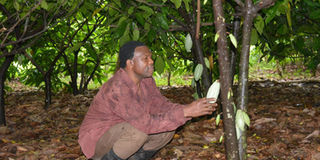Sironko farmer earns big from cocoa

Peter Mukone, holds a pod on one of the cocoa trees in his garden. PHOTO BY FRED WAMBEDE
What you need to know:
The biggest challenge facing the cocoa farmers is the high incidences of pests and diseases, which attacks the crops.
The other challenge is theft; people who steal the ripe cocoa pods from the plantations
Deep inside his cocoa plantation, Peter Mukone, 50, prunes his cocoa tree diligently and with passion.
“This allows air to flow through the plant freely. It prevents fungus from developing,” explains Mukone, a trader-turned-farmer.
The resident of Bumusi village, Buyobo Sub-county in Sironko District, started growing cocoa in 2005. He is well known as a cocoa farmer in Bugisu.
“I got the idea of cocoa growing from DR Congo, where I was a businessman.”
He adds that cocoa farmers, who were his business partners, taught him how to grow the crop.
“They taught me everything from preparing a nursery bed to transplanting seedlings, size of hole for planting and the spacing required for cocoa to thrive,” he says.
Favourable conditions
Mukone liked the idea, bought more than 180 pods of cocoa and transported them to Uganda from DR Congo.
From the pods, he extracted the seeds, which he planted and they matured into seedlings in 2006. He then transplanted these seedlings into 10 gardens totaling to more than 10 acres in Buyobo Sub-county.
He also planted more than 2,000 coffee trees to act as a shade for the cocoa plants.
“The cocoa plants thrive under shades and in areas with annual rainfall of between 1,500mm to 2,000mm. In Elgon region, our soils are suitable for growing these trees,” he says.
At first, he says his colleagues and relatives never liked his idea of abandoning his business deals in DR Congo and return home to grow cocoa.
Since he wanted to dispprove them, Mukone tended the crops well, did efficient weeding till the cocoa reached the flowering stage in two years.
In 2008, he started harvesting. Although the first year was not good, it has kept increasing as the plants mature.
“The harvest keeps on increasing with each passing year as the plants continue to grow,” he says.
During a great season between October and April, Mukone harvests more than 140 kilogrammes within two weeks. Each kilogramme of cocoa beans goes for Shs8,500.
“Cocoa is more valuable than coffee. It brings in more money and you can pick throughout the year,” he says, adding that the price of cocoa does not fluctuate like that of coffee.
Because cocoa is harvested throughout the year, cocoa farmers are assured of meeting their needs on daily basis.
Mukone says in order to maintain quality of the cocoa beans, farmers should collect and process it well, ferment the pods for four days and then dry the beans.
Knowledge of the type of the seeds plus the right site for plantation and preparation are necessary to harvest good quality cocoa beans.
Mukone grows Forastero, Trinitarion and Criollo varieties of cocoa, among others.
He now owns over 6,000 mature cocoa trees and 5,000 coffee trees in total. “And I keep growing more,” he says.
Market
The market for cocoa is available and to improve their bargaining power, the cocoa farmers in the region formed an association, Elgon Organic Cocoa Growers. It has a membership of more than 360 farmers.
“We now buy cocoa beans as an association. We store the produce and sell it to companies,” Mukone says.
A kilogramme of cocoa is currently bought at Shs8,000 and sold at Shs8,500 to several companies.
He says farmers in the region should grow more cocoa to improve their livelihoods and also to kill the tendency that cocoa is only grown in the western and central regions.
Achievements
Mukone says through the proceeds from cocoa growing, he has paid for the education of his children.
“I have paid school fees for my children. One of them is joining Makerere University,” he says. “With the earnings, I also take care of the family’s basic needs.”
Mukone adds that he has built connections with other farmers since he is seen as a model farmer in the region.
Challenges
The biggest challenge facing the cocoa farmers is the high incidences of pests and diseases, which attacks the crops.
The other challenge is theft; people who steal the ripe cocoa pods from the plantations.
Future plans
Mukone aims to grow 20,000 cocoa trees and 10,000 coffee trees in future.
He also wants to become an active facilitator and trainer of those who are interested in cocoa growing.
At the organisational level, as cocoa farmers, they want to establish a permanent primary society for farmers in the region.
cocoa varieties
Three main varieties of cocoa are grown in Africa:
Criollo: When Criollo pods are ripe, they are long, yellow or red, with deep furrows and big warts. This variety does not produce as much as the others but the cocoa is of very good quality.
Forastero (Amelonado): The pods are short, yellow, smooth without warts, with shallow furrows. This variety produces well but the quality is not as good as Criollo. It is grown a lot in Africa.
Trinitario: This variety is a cross between Criollo and Forastero. The pods are long or short, red and yellow. It yields cocoa of fairly good quality.




